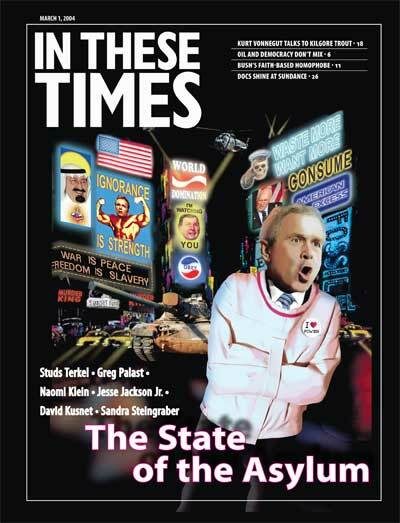
The Sundance Film Festival is part high school (did you get invited to the party?), part bazaar (check out high-fashion underwear, and drive the Tuareg!), and part dark-night-of-the-soul (freezing ankles while waiting for the bus).
Oh yeah, and then there’s the movies.
The festival that started out to celebrate the creativity of independent film artists has become a never-failing source of irony — one of the world’s most important film markets and, willy-nilly, the midwife of new Hollywood trends. And that’s not necessarily a bad thing.
Documentaries — less glamorous, more socially relevant, sometimes overtly political — were always the quieter side of Sundance. Not anymore. This year, Sundance opened with a splashy and historically insightful surfing doc, Riding Giants by Stacy Peralta, whose last hit was Dogtown and Z-Boys. Other documentarians with far less flashy fare captured the interest of the cell-phone brigades sent out by distributors.
Among the dozens of documentaries shown at Sundance, here are my faves. Most will end up on television and some will show up before that at a theater near you.
Control Room A great entry into the What They Really Think of Us genre for the High Imperial Era. Jehane Noujaim, a Lebanese-Syrian-American who earlier directed the critically acclaimed Startup.com, spent the three months of the U.S. invasion of Iraq at the headquarters of Al-Jazeera, the independent Arab TV news channel in Qatar. Watch Al-Jazeera’s resident intellectual, Hassan Ibrahim, face down U.S. Marine journalist-wrangler Josh Rushing. Catch the translator calmly interpret President Bush’s pronouncement and then wrinkle his nose with distaste. And listen to senior producer Sameer Khader explain why showing civilian casualties sounds like journalism to him. This is great cinema verité, and it’s a must-see for journalists. What was the hard part? “It was hard to see people who went to Al-Jazeera for freedom of speech and who expected U.S. support to be so disappointed,” said Noujaim. “And U.S. bombing of their offices was a terrible moment.”
Let the Church Say Amen Here’s one to make you revisit your prefab opinions of evangelical Christians. David Peterson spent a year with the members of a tiny storefront church in one of the most blasted-out corners of downtown Washington, D.C. For these African-Americans, the church provides the only social life, counseling and economic safety net they have. It’s not only a poignant tale of mutual support, it’s a damning condemnation of a government and society (there’s a pointed clip of Bush near the end) that leaves it to a storefront ministry to meet whole lives’ worth of needs. Peterson brought several members of the church to Sundance. “Several have never been on an airplane,” he said. “It’s such a joy that their story is told here.”
Super Size Me Ever wonder what happens to people who eat at McDonald’s all the time? Morgan Spurlock, a New Yorker in film production whose girlfriend is a vegan chef, decided to find out when he read about a lawsuit against McDonald’s. The film goes with him across the country as he eats breakfast, lunch and dinner under the Golden Arches, and takes on the pounds and liver damage to prove it. Along the way he also takes on the entire fast-food industry, especially for its Pied Pipering of children. It’s Michael Moore-ish without the diffuse hostility. This was one of the hotter tickets at Sundance; Spurlock won best doc director, and cable channel A&E laid claim to it after a theatrical run. It should be shown in schools everywhere.
Deadline A great film for anyone working against the death penalty. Katy Chevigny and Kirsten Johnson follow the path toward the decision of plain-speaking former Illinois Gov. George Ryan to commute the sentences of 167 death-row inmates. Along the way, we meet some wrongfully convicted men, freed not because of the legal system but because of journalism students’ research at Northwestern University. Ryan showed up at the Sundance premiere, as did some of the wrongfully convicted. They reminded partygoers that they can support anti-death penalty work by going to deadlinethemovie.com and clicking “take action,” and so can you.
Heir to an Execution A far more personal take on the death penalty, and possibly the last word on the Rosenberg executions. Granddaughter Ivy Meeropol, with investment from HBO (where the film will end up), explores her grandparents’ story. The issue is no longer guilt or innocence. Her family accepts that Julius conducted industrial espionage but did not commit the crime for which he was executed, and Ethel was innocent. She instead sets out to understand why Julius and Ethel accepted execution and the context of the terrible event. The star of the film is her father, the charismatic and loving Michael Meeropol, who can still recall the horrifying events of his early youth moment-by-moment.
Farmingville Another cinema verité triumph, taking us inside an America all around us that we don’t usually look at. Carlos Sandoval and Catherine Tambini spent three years in a small working-class town in Long Island, where mostly illegal Mexicans have been congregating to take the jobs Americans won’t do in Long Island’s wealthier towns. They chronicle the rise of a mostly white, anti-immigrant movement that erupts into hate crimes and chart how local governments and organizations struggle to resolve the conflict. The film, funded by a special public TV fund to foster diversity, won a special jury prize, and will air on public TV’s leading series for independent work, P.O.V. later this year. (So will another Sundance film funded by public TV’s Independent Television Service, Chisholm ’72 Unbought and Unbossed, an important slice of election history.)
International documentaries have usually taken a back seat at Sundance, but coprogrammer Diane Weyermann, a lawyer who used to head the human rights-oriented Soros Documentary Fund, is changing that. This year a clutch of remarkable films provided small but important windows into vast realities beyond our borders. My favorites included:
Disbelief Who really set the bombs that blew up an entire Moscow apartment complex, and with it a young woman’s mother and boyfriend? St.Petersburg-based filmmaker Andrei Nekrasov is pretty sure he’s found the people who know the answer. They charge that President Putin’s government has created horrific terrorist incidents and blamed them on Chechen nationalists, in order to create support for its unpopular leadership. The gripping film features the young woman and her sister, married to a Wisconsin man.
“We searched for a U.S. character because we wanted to win international attention for this issue,” Nekrasov said. “Governments can too easily use terrorism as a weapon to intimidate their own publics. An undemocratic country is now a threat to the entire world.”
Screaming Men In a rare upbeat offering, Mika Ronkainen gives us an insider’s look at an astonishing Finnish Screaming Men’s Choir. Led by the fanatical Petri Serviö, who invented it, choir members dress like Agent Smith (of the Matrix) and strut to their places robotically, at which time they holler, chant and scream national anthems and folk songs in unison. They say it’s very cathartic. It’s also popular worldwide. It’s true: Life is strange. Ronkainen told me he thinks it gets even stranger north of Helsinki.
I hope you found this article important. Before you leave, I want to ask you to consider supporting our work with a donation. In These Times needs readers like you to help sustain our mission. We don’t depend on—or want—corporate advertising or deep-pocketed billionaires to fund our journalism. We’re supported by you, the reader, so we can focus on covering the issues that matter most to the progressive movement without fear or compromise.
Our work isn’t hidden behind a paywall because of people like you who support our journalism. We want to keep it that way. If you value the work we do and the movements we cover, please consider donating to In These Times.








